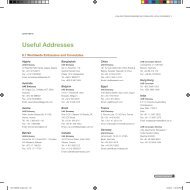Arab World Competitiveness Report 2011-2012 - World Economic ...
Arab World Competitiveness Report 2011-2012 - World Economic ...
Arab World Competitiveness Report 2011-2012 - World Economic ...
Create successful ePaper yourself
Turn your PDF publications into a flip-book with our unique Google optimized e-Paper software.
1. A Time of Opportunities: The <strong>Competitiveness</strong> Performance of the <strong>Arab</strong> <strong>World</strong><br />
<strong>Arab</strong> <strong>World</strong> <strong>Competitiveness</strong> <strong>Report</strong> <strong>2011</strong>-<strong>2012</strong><br />
24<br />
Syria (98th) faces a number of important challenges<br />
related to competitiveness, some of which have led to<br />
ongoing social unrest since early <strong>2011</strong>. Labor markets<br />
are among the most inefficient worldwide (134th), due<br />
to factors such as lack of meritocracy (139th) and<br />
low female participation (141st). Entrepreneurs also<br />
face significant rigidities when employing workers or<br />
adjusting the workforce to their needs. In fact, Syria<br />
ranks 93rd for labor market flexibility. Other markets<br />
suffer equally from inefficiencies. Financial markets are<br />
underdeveloped (117th), and access to finance remains<br />
constrained for the business sector (108th) across<br />
different types of products and services. However, in<br />
developing its financial markets, the country can build<br />
on a relatively sound banking system (59th). Progress in<br />
goods market efficiency will be crucial for Syria to raise<br />
its competitiveness. Markets remain to a large degree<br />
dominated by few firms (118th), anti-monopoly policy<br />
is inefficient (90th), and foreign competition remains<br />
constrained by high tariffs (122nd), other trade barriers<br />
(127th), cumbersome customs procedures (133rd), and<br />
rules governing FDI that discourage foreign investors<br />
(112th).<br />
A longer-term challenge is to upgrade the educational<br />
system. Although the quality of primary education is<br />
satisfactory (67th), higher education and training lag<br />
behind those of other economies, and are among<br />
the key weaknesses in the country’s competitiveness<br />
framework. Educational outcomes are poor both in<br />
terms of enrolment rates in secondary and tertiary<br />
education (98th and 78th, respectively) and in terms<br />
of quality of teaching, which is particularly poor in<br />
management schools (108th) and requires better<br />
alignment to business needs (96th). <strong>Competitiveness</strong>enhancing<br />
reforms would lift the country onto a higher<br />
growth path, which in turn would enable it to pursue<br />
greater social cohesion.<br />
Conclusions<br />
This chapter has analyzed the performance of 14 <strong>Arab</strong><br />
countries in terms of national competitiveness using<br />
the framework of the Global <strong>Competitiveness</strong> Index.<br />
The countries analyzed include Algeria, Bahrain, Egypt,<br />
Jordan, Lebanon, Morocco, Kuwait, Oman, Qatar, Saudi<br />
<strong>Arab</strong>ia, Syria, Tunisia, United <strong>Arab</strong> Emirates, and Yemen.<br />
The analysis shows that the countries are highly diverse<br />
in terms of national competitiveness. While most Gulf<br />
economies benefit from vast natural resources and rising<br />
energy prices, and have used the ensuing revenues in<br />
recent years for improvements in their competitiveness,<br />
the challenges are more profound in North Africa and<br />
the Levant. Economies in these two sub-regions –<br />
with the notable exception of Tunisia, which ranks a<br />
strong 40th out of 142 countries – display numerous<br />
competitive weaknesses that will have to be addressed<br />
going forward, especially in light of the employment<br />
challenges these countries face. Most important,<br />
education systems must be upgraded to better respond<br />
to the needs of business, and markets must be made<br />
more efficient by moving towards healthier competition,<br />
fostering entrepreneurship, and supporting a more<br />
dynamic environment for enterprises. Education and<br />
market efficiency are the two key aspects that would<br />
address crucial supply- and demand-side challenges to<br />
job creation.<br />
The <strong>Arab</strong> Spring has led to significant turbulence in<br />
the region, which will likely influence the economic and<br />
competitive performance of countries in the shorter<br />
and longer term. Uncertainty about the future business<br />
environment, as well as a heightened awareness of<br />
some institutional weaknesses, may have adverse<br />
effects in the short term. However, the political<br />
changes and the recognition of the need to create<br />
private-sector employment have significant potential<br />
to drive the political momentum needed for enhanced<br />
competitiveness in the medium term.<br />
Creating gainful employment for their populations is<br />
currently the key challenge for most of the countries<br />
from the region. <strong>Competitiveness</strong>-enhancing reforms<br />
will pave the way to more private-sector activity that<br />
will lead to the creation of gainful and sustainable<br />
employment across the region for the benefit of both<br />
present and future generations.





